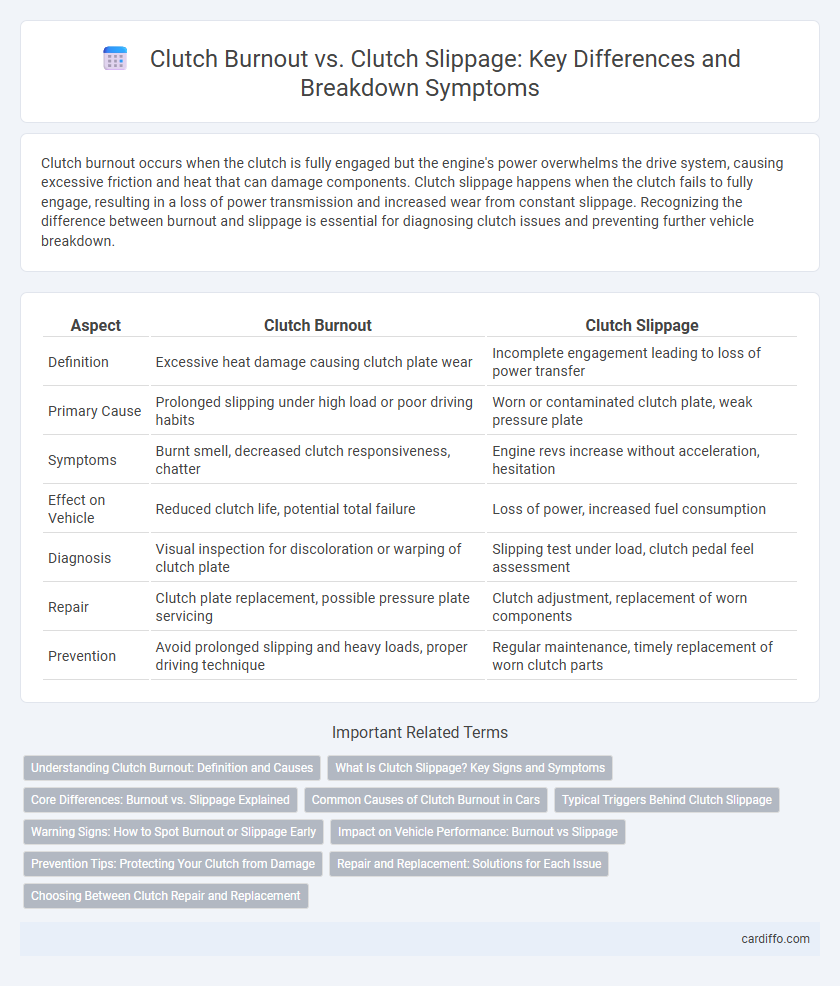Clutch burnout occurs when the clutch is fully engaged but the engine's power overwhelms the drive system, causing excessive friction and heat that can damage components. Clutch slippage happens when the clutch fails to fully engage, resulting in a loss of power transmission and increased wear from constant slippage. Recognizing the difference between burnout and slippage is essential for diagnosing clutch issues and preventing further vehicle breakdown.
Table of Comparison
| Aspect | Clutch Burnout | Clutch Slippage |
|---|---|---|
| Definition | Excessive heat damage causing clutch plate wear | Incomplete engagement leading to loss of power transfer |
| Primary Cause | Prolonged slipping under high load or poor driving habits | Worn or contaminated clutch plate, weak pressure plate |
| Symptoms | Burnt smell, decreased clutch responsiveness, chatter | Engine revs increase without acceleration, hesitation |
| Effect on Vehicle | Reduced clutch life, potential total failure | Loss of power, increased fuel consumption |
| Diagnosis | Visual inspection for discoloration or warping of clutch plate | Slipping test under load, clutch pedal feel assessment |
| Repair | Clutch plate replacement, possible pressure plate servicing | Clutch adjustment, replacement of worn components |
| Prevention | Avoid prolonged slipping and heavy loads, proper driving technique | Regular maintenance, timely replacement of worn clutch parts |
Understanding Clutch Burnout: Definition and Causes
Clutch burnout occurs when the clutch disc overheats due to excessive friction caused by prolonged or aggressive engagement, leading to glazing or severe wear. Common causes include riding the clutch pedal, frequent stop-and-go driving, and improper clutch adjustment, which generate excessive heat and reduce clutch performance. Understanding these factors is crucial for preventing damage and maintaining optimal clutch function.
What Is Clutch Slippage? Key Signs and Symptoms
Clutch slippage occurs when the clutch disc fails to fully engage, causing a loss of power transmission between the engine and transmission. Key signs of clutch slippage include a noticeable reduction in acceleration despite high engine RPMs, a burning smell from the clutch area, and difficulty maintaining vehicle speed under load. Symptoms often worsen during gear shifts or hill climbs, indicating worn clutch components or improper clutch adjustment.
Core Differences: Burnout vs. Slippage Explained
Clutch burnout occurs when the clutch is fully engaged but the engine RPM rises without corresponding vehicle acceleration, often caused by excessive wheel spin during aggressive starts. Clutch slippage happens when the clutch partially engages, allowing the engine to turn faster than the transmission, resulting in loss of power and increased wear due to heat and friction. The core difference lies in engagement: burnout involves full clutch engagement with slipping at the wheels, while slippage involves incomplete clutch engagement between the engine and transmission.
Common Causes of Clutch Burnout in Cars
Clutch burnout in cars commonly results from excessive riding of the clutch pedal, causing continuous friction and overheating of the clutch components. Aggressive driving habits such as rapid acceleration and frequent gear changes under high engine loads increase wear and lead to premature clutch failure. In contrast, improper clutch adjustment and oil contamination typically contribute more to clutch slippage rather than burnout.
Typical Triggers Behind Clutch Slippage
Clutch slippage typically occurs due to worn clutch plates, insufficient clutch pedal adjustment, or contamination from oil or grease on the clutch disc. Poor driving habits such as riding the clutch, frequent stop-and-go traffic, or towing heavy loads can accelerate the wear and cause the clutch to slip. Mechanical issues like weak pressure springs or a malfunctioning hydraulic system also contribute to clutch slippage, resulting in reduced power transmission and poor vehicle performance.
Warning Signs: How to Spot Burnout or Slippage Early
Warning signs of clutch burnout include a burning smell, difficulty shifting gears, and a spongy clutch pedal, while clutch slippage typically presents as a sudden drop in acceleration or engine rev revving without corresponding speed increase. Early detection of clutch slippage involves noticing delayed clutch engagement and increased engine RPMs during acceleration. Monitoring these indicators helps prevent extensive damage and costly repairs by addressing clutch issues promptly.
Impact on Vehicle Performance: Burnout vs Slippage
Clutch burnout results in excessive heat and wear, leading to reduced clutch lifespan and diminished power transmission, which severely affects acceleration and overall vehicle responsiveness. Clutch slippage causes a loss of torque transfer, reducing engine efficiency and fuel economy while causing inconsistent acceleration and potential drivetrain damage. Both conditions degrade performance, but burnout typically leads to faster clutch failure, whereas slippage results in gradual power loss and drivability issues.
Prevention Tips: Protecting Your Clutch from Damage
Prevent clutch burnout and clutch slippage by avoiding excessive riding of the clutch pedal and ensuring smooth, gradual engagement during gear shifts. Regularly inspect and adjust the clutch cable or hydraulic system to maintain optimal tension and responsiveness. Use high-quality clutch fluid and replace it according to the manufacturer's schedule to prevent contamination and maintain hydraulic integrity.
Repair and Replacement: Solutions for Each Issue
Clutch burnout repair typically involves replacing the entire clutch assembly, including the pressure plate, clutch disc, and release bearing, to restore full functionality. Clutch slippage can often be addressed by resurfacing the flywheel and replacing the clutch disc, though severe cases may also require a complete clutch replacement. Proper diagnosis ensures targeted repairs, reducing downtime and preventing further drivetrain damage.
Choosing Between Clutch Repair and Replacement
Clutch burnout causes excessive heat damage to the clutch plates, typically necessitating replacement due to irreversible wear, while clutch slippage often results from worn friction material that can sometimes be addressed through repair or resurfacing. Assessing the severity of the damage, such as heat warping versus material thinning, guides the choice between clutch repair and full replacement. Professional diagnostics, including pressure tests and visual inspection, ensure optimal performance restoration and prevent further transmission issues.
Clutch burnout vs clutch slippage Infographic

 cardiffo.com
cardiffo.com